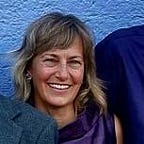Grant Butte Wetlands Natural Area
In 2014, Metro, the Portland-area regional government, purchased 33 acres of bottomland at Grant Butte. The land had been farmed, and plans were to restore it to its original wetland habitat.
After visiting the farm and interviewing Ed Grimm and Darlene Grimm, daughter of Henry Gantenbein, the last farmer on the land, I wrote this article for a Metro publication. In September 2014, I gave the following presentation, tracing the land’s history to its geologic roots, at a community celebration of the acquisition. I wanted to honor the Gantenbeins’ history on the land, as the last stewards before restoration to a more natural state commenced under Metro and Gresham’s ownership.
At the end is the latest update on Grant Butte, a 2017 post from Metro.
This photo shows the dairy’s setting at the base of Grant Butte’s east side. The water at left flows in a ditch dug by Henry Gantenbein to channel water off land used for grazing
Lewis and Clark wrote of the people at the lakes, the Nechacokees. Because of the year-round abundance of food — fish, elk and other game, berries, wapato and camas– they were not nomadic.
They would have traveled inland from the river to trap beaver in the wetlands along the base of the butte, and perhaps fish for crawdad and trap game birds. Epidemics in the late 1700s and 1830s killed most of those who lived there, and elsewhere along the Columbia.
Trapping continued to the early 1840s when the Oregon country was trapped out and European demand for beaver hats evolved into other fashions. Most trapping was during winter, when beavers’ fur grows thickest. The trapper would visit the trap often, resetting it over and over until he had trapped out an area.
The cemetery is at 198th and Powell. First burial: 1880. It had been part of St. Joseph’s parish; now cared for by Mt. Calvary Cemetery in Portland. Now surrounded by Berry Ridge apartments.
Construction on the pipe, called Conduit 1, was started in 1893; by 1895, the pipeline, ending at Mt. Tabor’s Reservoir 1, began providing roughly 25 million gallons per day.
Trains carried passengers until 1927 and later carried freight into the 1960s.
By the early 1930s its annual hill climb tour, held in June, traveled from Portland out Section Line Road (now Division) and up the north side of Grant Butte. Newspaper accounts report an “80 degree pitch” near the top. The club still exists: Rose City Motorcycle Club
Henry’s father Christian followed his brother John to America at that time.
After arriving in the U.S. and working for John at his dairy in Cleon (now Fairview), in 1912 Christian and his wife Anna bought 80 acres of logged-off land in Boring and raised dairy cattle.
After Christian’s death in 1922, 9-year-old Henry took over the dairy’s day to day operations with the help of his uncles. With four younger siblings to support, he was not able to go to high school. Once the last child graduated high school, Henry moved off the Boring farm.
He and his wife Arletha arrived at the Grant Butte property in 1948 and purchased the land in 1950.
There, they raised dairy cattle until 1990, and then kept beef cattle. From the 1960s they also sold alfalfa they trucked in from Eastern Oregon and Washington and the Klamath River.
The program was sponsored by Oregon State Extension, Oregon Dairymen’s Assoc. and the Oregon Dairy Products Commission to upgrade the appearance of the state’s dairies.
Milking happened twice a day, 4 a.m. and 4 p.m. In between, Henry tended his large garden.
Henry’s daughter Darlene said her dad had endless energy. He snacked on his vegetables right out of the garden. His habit of eating raw garlic throughout the day, she says, “kept him going.”
The land will be protected as a natural area, both for wildlife and to provide close access to nature for residents of the Centennial neighborhood and the region. The land was purchased with funds from the voter-approved Natural Areas bond measure in 2006. This voter support has allowed Metro and its partners — Gresham in this case — to buy lands for regional trails, to provide close access to nature, to preserve habitat for wildlife, and to protect water quality.
This land had been sold by Darlene Grimm and her brother Bob Gantenbein to Chet Antonsen in 2011. In May 2014, he sold it to Metro and the City of Gresham. EMSWCD provided a $1 million grant toward the purchase.
Here they move through non-native reed canarygrass. Used for pasture, this area will be restored to wetlands. Since the first settlers arrived in Oregon, over half our the state’s wetlands have been converted to agricultural or other uses.
Turtles, frogs, newts, river otter and waterfowl live in these wetlands and those to the south, in Southwest Community Park, 19 acres that had once been farmed. Restoration work there included recreating meanders in the area where the drainage ditch once ran, removing invasive species and replanting with plants indigenous to the land.
Barns, other structures and concrete pads were removed in late 2014 and the soil ripped to counter effects of compaction from farm equipment over the years.
Some of the homes were vacant at that time. Darlene and Ed Grimm, who still lived on the property, moved in late 2014.
Conservation targets are: turtles, wetlands, and upland habitats. First came the initial restoration and site stabilization work: weed removal, mowing, chain-sawing invasive trees, treating stumps, removing hazardous materials, and removal of buildings
Metro and Gresham, with EMSWCD will create a longterm site conservation and management plan. Public access will be part of that plan.
